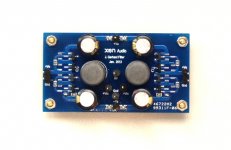PCB size would be enough for now and whether or not it could/should be stacked with the 9022 PCB somehow; I just need to test various layouts in Google SketchUp. 🙂
PCB size is 55x30mm (tiny).
4x M2 mounting posts on 49x24mm rectangle.
Should NOT be stacked with the 9022 PCB.
Patrick
4x M2 mounting posts on 49x24mm rectangle.
Should NOT be stacked with the 9022 PCB.
Patrick
I have put some more information about the buffer on the Zen-Cen-Sen thread especially concerning aliasing. There i put up an argument that higher mathematics can be reduced to addition, multiplication, subtraction and division. Multiplication can then be reduced to massive addition, a fact that that made Pacals Pascaline possible.
The problem is then to reduce division to massive subtraction, a problem that Leibnitz tried to solve with an "overflow wheel". The actual mechanical objects never worked in the day but as far as i know in modern times a working prototype has being made that approved that the concept is right. That leaves us to the idea that we need only massive addition. Leibnitz solution was the binary code of 1 and 0. My thoughts recently went into the direction if we can skip the 0. Call me crazy but when i am right you have seen that idea here the first time, just for the record.
The problem is then to reduce division to massive subtraction, a problem that Leibnitz tried to solve with an "overflow wheel". The actual mechanical objects never worked in the day but as far as i know in modern times a working prototype has being made that approved that the concept is right. That leaves us to the idea that we need only massive addition. Leibnitz solution was the binary code of 1 and 0. My thoughts recently went into the direction if we can skip the 0. Call me crazy but when i am right you have seen that idea here the first time, just for the record.
Of cause skipping the 0 was a joke 🙂 .On the other hand i am thinking sometimes if binary code is the end of the story and one day some genius may come along with an even more efficient way to crush the numbers.
The first prototype of our J Gerhard Filter Buffer is working.
We'll do some listening on the ES9022 as well as our "new" PCM5102 modules, before sending it to Joachim for his final approval.
http://www.diyaudio.com/forums/digi...t-output-two-digital-filters.html#post3021929
🙂
Patrick
We'll do some listening on the ES9022 as well as our "new" PCM5102 modules, before sending it to Joachim for his final approval.
http://www.diyaudio.com/forums/digi...t-output-two-digital-filters.html#post3021929
🙂
Patrick
Attachments
That looks very good !
And you got the brand new PCM5102. That claims very little out of band noise to begin with.
And you got the brand new PCM5102. That claims very little out of band noise to begin with.
question regarding ES9023 MCK input - Is there a recommended value to supply ES9023 - can that be more than 50 MHz
I see that It Is used 48 Mhz from XO to ES9023 and 12 Mhz to WM8804 but
If we want to use I2S - without WM8804 and we have at transport 16.9344 Mhz - can I supply ES9023 with 4 x 16.9344 MHz
I see that It Is used 48 Mhz from XO to ES9023 and 12 Mhz to WM8804 but
If we want to use I2S - without WM8804 and we have at transport 16.9344 Mhz - can I supply ES9023 with 4 x 16.9344 MHz
Joachim,
I'll see if we have time to build you a PCM5102 48MHz so that you can also test with your current WM8804 modules.
We have enough PCBs, just no time.
🙁
Patrick
I'll see if we have time to build you a PCM5102 48MHz so that you can also test with your current WM8804 modules.
We have enough PCBs, just no time.
🙁
Patrick
Thanks, Patrick for the offer. I certainly know the time problem. I took some days off from designing and that did me really good.
thx for reply Patrick
can I use ES9023 at 16.9344 or It Is better to go higher as It can to 50 MHz
can I use ES9023 at 16.9344 or It Is better to go higher as It can to 50 MHz
No. I meant synchronous mode.
That is why I use 45.1584MHz XO which is divided by 4 to clock the QA550 also from the same XO.
If his CD player use 16.9344 and can be fed the CLK signal externally, he should then use 33.8688MHz XO.
He can then divide by 2 to get 16.9344 for the CD, while the ES9022 operates at 33.8688.
No such game for WM8804. SPDIF always involves a PLL I am afraid. 🙂
Patrick
That is why I use 45.1584MHz XO which is divided by 4 to clock the QA550 also from the same XO.
If his CD player use 16.9344 and can be fed the CLK signal externally, he should then use 33.8688MHz XO.
He can then divide by 2 to get 16.9344 for the CD, while the ES9022 operates at 33.8688.
No such game for WM8804. SPDIF always involves a PLL I am afraid. 🙂
Patrick
Hi I misread the previous posts (without WM8804)
BTW I am very happy with WM8804, no more existing CS84XX or DIR products for me anymore unless a new one will be developed that surpasses WM8804/5..
BTW I am very happy with WM8804, no more existing CS84XX or DIR products for me anymore unless a new one will be developed that surpasses WM8804/5..
Last edited:
- Status
- Not open for further replies.
- Home
- Source & Line
- Digital Line Level
- Anybody using the new ESS Vout DAC (ES9022)?
